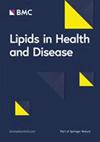残余胆固醇与空腹血糖受损后恢复正常之间的非线性关系:一项多中心队列研究
IF 3.9
2区 医学
Q2 BIOCHEMISTRY & MOLECULAR BIOLOGY
引用次数: 0
摘要
残余胆固醇(RC)是一种强效的致动脉粥样硬化脂质,已被证明与胰岛素抵抗和糖尿病的发病机制密切相关。然而,空腹血糖受损(IFG)患者体内残余胆固醇与正常血糖逆转之间的关系至关重要,目前仍不清楚。这项调查旨在澄清这种关系,对于了解和改善糖尿病的管理非常重要。这项研究纳入了2010年至2016年期间中国11个城市的15019名空腹血糖受损患者,研究过程十分严谨。Cox回归分析揭示了IFG患者RC与正常血糖逆转之间关系的有趣发现。通过平滑曲线拟合技术和 4 节受限立方样条函数,进一步探讨了潜在的非线性关联,确保了分析的全面性。为了检验结果的有效性,还进行了一系列亚组和敏感性分析,进一步增强了研究结果的稳健性。在 2.89 年的中位随访期结束时,15,019 名 IFG 参与者中有 6,483 人(43.17%)已恢复正常血糖。研究结果表明,RC 水平的增加与血糖恢复正常的可能性成反比,这一发现既新颖又重要。根据完全调整后的考克斯比例危险模型分析,在 IFG 参与者中,RC 每增加一个标准差,正常血糖逆转的可能性就会降低 20%(HR:0.80,95% CI:0.77-0.82)。RC 与血糖正常值逆转之间存在非线性关系,在 41.37 mg/dL 时出现拐点。这表明,在达到拐点后,血糖逆转可能性的增长率下降并趋于稳定。此外,在不同年龄组之间还观察到了明显的交互作用,从而使人们对这一复杂的关系有了更细致的了解。在患有 IFG 的中国成年人中,RC 与正常血糖逆转的概率呈负非线性关系。当 RC 水平达到或超过 41.38 毫克/分升时,血糖正常的概率逐渐降低,随后趋于稳定。将 RC 水平维持在 41.38 毫克/分升以下可显著提高 IFG 患者(尤其是 60 岁或以上的患者)的正常血糖逆转概率。本文章由计算机程序翻译,如有差异,请以英文原文为准。
Nonlinear association between remnant cholesterol and reversion from impaired fasting glucose to normoglycemia: a multicenter cohort study
Remnant cholesterol (RC), a potent atherogenic lipid, has been shown to be strongly correlated with insulin resistance and the pathogenesis of diabetes mellitus. However, the relationship between RC and normoglycemia reversal in individuals with impaired fasting glucose (IFG) is crucial and remains unclear. This investigation, which aimed to clarify this association, is important for understanding and potentially improving the management of diabetes. This study, which included 15,019 IFG participants from 11 Chinese cities between 2010 and 2016, was conducted with a rigorous research process. Cox regression analysis revealed intriguing findings regarding the relationship between RC and normoglycemia reversal in individuals with IFG. Potential nonlinear associations were further explored via smooth curve-fitting techniques and 4-knot restricted cubic spline functions, ensuring a comprehensive analysis. To examine the validity of the results, an array of subgroup and sensitivity analyses were conducted, further bolstering the robustness of the findings. By the end of the 2.89-year median follow-up period, 6,483 of the 15,019 IFG participants (43.17%) had reverted to normoglycemia. The findings, which reveal that increased RC levels are inversely associated with the likelihood of normoglycemia reversal, are novel and significant. According to the fully adjusted Cox proportional hazards model analysis, an increase of one standard deviation in RC was associated with a 20% decrease in the likelihood of normoglycemia reversal among IFG participants (HR: 0.80, 95% CI: 0.77–0.82). A nonlinear association between RC and normoglycemia reversal was observed, with an inflection point at 41.37 mg/dL. This suggests that the growth rate of the likelihood of reversion decreased and stabilized after the inflection point was reached. Moreover, significant interactions were observed between the age groups, providing a more nuanced understanding of this complex relationship. Among Chinese adults with IFG, RC exhibited a negative nonlinear relationship with the probability of normoglycemia reversal. When RC levels reached or exceeded 41.38 mg/dL, the probability of achieving normoglycemia progressively diminished and subsequently stabilized. Maintaining RC levels below 41.38 mg/dL can significantly improve the probability of normoglycemia reversal among individuals with IFG, especially those aged 60 years or older.
求助全文
通过发布文献求助,成功后即可免费获取论文全文。
去求助
来源期刊

Lipids in Health and Disease
生物-生化与分子生物学
CiteScore
7.70
自引率
2.20%
发文量
122
审稿时长
3-8 weeks
期刊介绍:
Lipids in Health and Disease is an open access, peer-reviewed, journal that publishes articles on all aspects of lipids: their biochemistry, pharmacology, toxicology, role in health and disease, and the synthesis of new lipid compounds.
Lipids in Health and Disease is aimed at all scientists, health professionals and physicians interested in the area of lipids. Lipids are defined here in their broadest sense, to include: cholesterol, essential fatty acids, saturated fatty acids, phospholipids, inositol lipids, second messenger lipids, enzymes and synthetic machinery that is involved in the metabolism of various lipids in the cells and tissues, and also various aspects of lipid transport, etc. In addition, the journal also publishes research that investigates and defines the role of lipids in various physiological processes, pathology and disease. In particular, the journal aims to bridge the gap between the bench and the clinic by publishing articles that are particularly relevant to human diseases and the role of lipids in the management of various diseases.
 求助内容:
求助内容: 应助结果提醒方式:
应助结果提醒方式:


